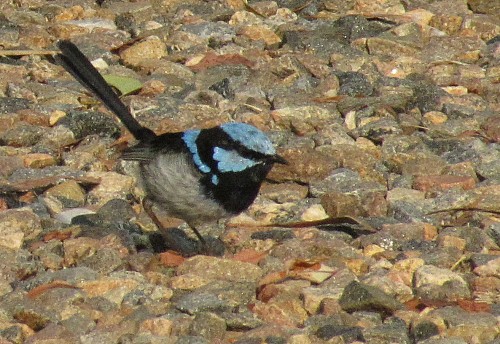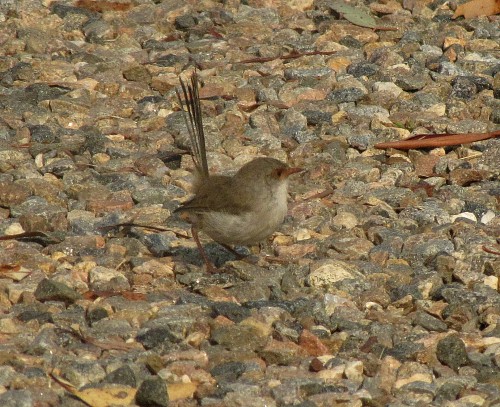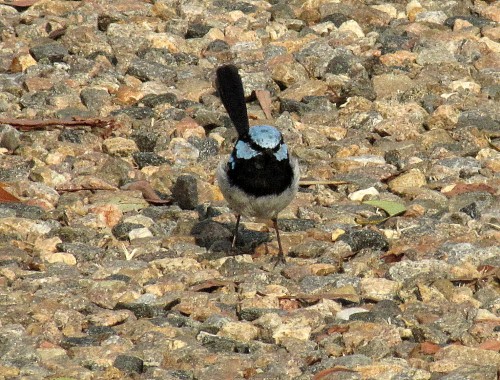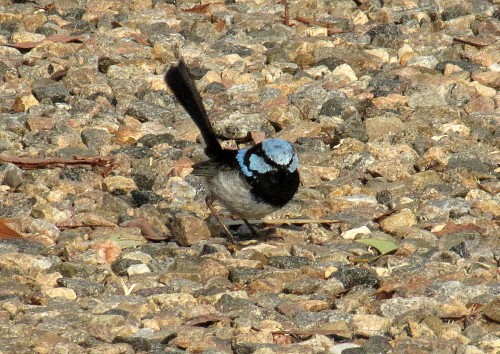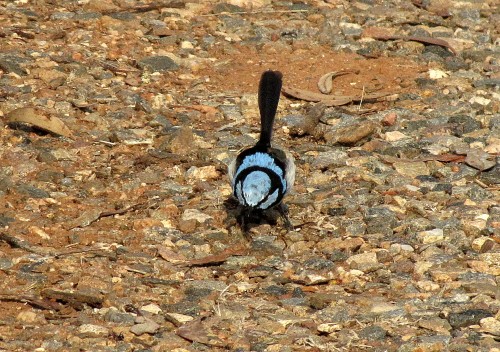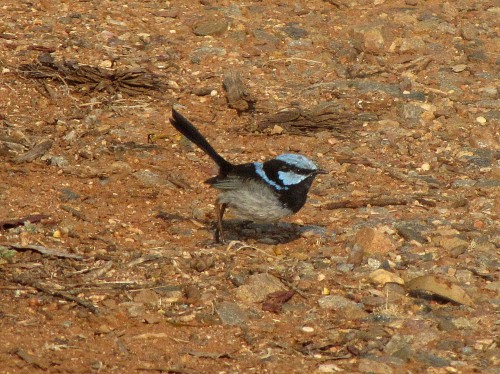Our wrens are back!
Our wrens are back!
When I say “our”, I mean the family of Superb Fairy-wrens who have decided to call our garden their home. Ever since we got back from our recent trip to visit family in Sydney we haven’t seen or heard them. That’s nearly a month and we missed not having them around.
This morning, while having breakfast in our sun-room, we saw two of them fussing around in the bushes near the bird bath. Both of them briefly visited the water for a quick drink. One was an uncoloured male and the other a female. Originally we only had two, a male and female. Then last year a third one joined them; we assume that they had nested and the third one was their offspring.
Now where have they been for the last month or so? In fact, thinking about it, we haven’t heard or seen them since well before we left for Sydney about 7 weeks ago. Have they been quietly nesting somewhere? And if they have been breeding, how many in their family group now? I guess time will tell.
Meanwhile we are looking forward to their cheerful trilling as they feed in the garden and nearby mallee scrub. And we also enjoy seeing them hopping and flitting around as we go about our daily tasks.
The photo of a fully coloured male above was taken in our driveway earlier this year.
Superb Fairy-wrens in our garden
Over the almost30 years we have lived in our present home we have rarely seen any wrens in our garden, part of a five acre block of fruit trees and mallee scrub with some native Australian plants thrown in for good measure. In most cases these occasional visitors were the locally common Variegated Fairy-wren. There are several thriving families up the hill in a mallee and native pine reserve about a kilometre away.
In other parts of Murray Bridge the Superb Fairy-wren is the common and dominant species. Just over a year ago we came back from an overseas holiday to be greeted with two Superb Fairy-wrens having quite happily taken up residence in our garden in our absence. It was a delightful welcome home present. In the coming months we saw them frequently, much to our continued delight.
Then they went quiet for a few weeks. Mmmm… had they moved on, we wondered?
To our increased delight they now number three: a coloured male and two uncoloured birds. Had they recruited another from nearby, or was the new one an offspring? We’ll never know. In recent days I’ve seen the three of them often, but sadly the male in in eclipse plumage and has lost most of his colour. In fact, he looks decidedly scruffy, not the magnificent colours shown in today’s photos. These shots were taken a few weeks ago. I also managed a good shot of one of the females (or uncoloured male?).
I should explain that all of these photos were taken in our gravel covered driveway. Our garden is far more attractive than it appears in these photos.
Beautiful Superb Fairy-wren
This morning I was sitting in our sun room doing some reading. I looked up and saw the male Superb Fairy-wren shown above and grabbed the camera before it flitted off into the vegetation. I had to take about four steps to get the camera and I was delighted that the bird stayed in position until I could focus and shoot. I only had time to manage one photo, but I’m quite happy with it. This species – like all of our wrens – are very flighty birds, never staying in one spot for more than a second or two – at best.
This individual, along with two uncoloured birds, has been resident in our garden now for over a year. This is delightful because, until a year ago, we had only recorded this species on a handful of occasions over the previous 28 years, despite them being common in our region. My next challenge is to get a shot of a female, preferably alongside the male.
The flowers belong to a Melaleuca lanceolata bush in our garden. It’s a common plant species in our area. For more about Australian native plants, have a look at my wife’s site, Mallee Native Plants.
My readers might like to also see photos of the Red-backed Fairy-wren over at Snail’s Eye View. This is one species I still have the delight to see in the wild.
Some of the photos shown here on Trevor’s Birding can now be purchased on tee shirts, coffee mugs, stationary and a large range of other items. Go to Trevor’s Photos site here.
Superb Fairy-wrens take a bath
We used to have a few wrens in our garden from time to time, mainly in the late 1980s and early 1990s. On all occasions they were Variegated Fairy-wrens, which is not the dominant wren species of the region.
About a year ago on our return from six weeks’ holiday overseas, we were greeted by two Superb Fairy-wrens, a male and a female, who had taken up residence in our absence. (Read about that here.) We have seen them almost every day since – except for the last month. Suddenly they have reappeared, this time with a third, uncoloured, bird. It is entirely possible that they have nested nearby without telling us, or giving away the location of their nest.
All three birds took delight in having a good splash in one of our bird baths yesterday while I was finishing my breakfast and trying to complete the crossword in the paper. Sadly, I wasn’t quick enough with the camera, so I’ll use a photo taken elsewhere on another occasion.
A nice welcome home
I’ve been a little quiet here over the last seven weeks. I’ve been overseas on a wonderful holiday. Stay tuned for plenty of wonderful photos of the birds of Ethiopia, Morocco and Spain in the coming months. In each country I saw about 30 species that I’d never seen before. The actual number is a bit rubbery as I’ve yet to identify some of the birds I photographed. Some long hours of interesting research ahead for me.
After a direct and very tedious journey home via Madrid, Dubai, Kuala Lumpur and Melbourne, we arrived at Adelaide Airport at 8am on Wednesday. Due to the blurriness of jet lag the rest of day was basically survival mode.
Thursday morning (yesterday) was a different matter. At breakfast time we had two Superb Fairy-wrens feeding in our garden, a male as shown in the photos, and a female. This species is widespread and common in our district here in South Australia, but this is the first time we’ve seen it in our garden in nearly 30 years living here. (On 5 occasions we have had Variegated Fairy-wrens visit over the same time period, the last being over 10 years ago.)
So, not only were we greeted with these lovely birds on our first day home, I was able to add a new species to our “home list”. Very nice.
Even better: they were around again this morning. I hope they find our garden enticing and decide to take up residence.
I managed only 2 photos of the male; the female was a little on the shy side and wouldn’t sit still long enough in the open for a shot.

